4-Chloro-3-fluorobenzoic Acid: A Key Intermediate in Chemical Synthesis
Unlocking innovation in pharmaceuticals, agrochemicals, and material science with this essential building block.
Get a Quote & SampleProduct Core Value

4-Chloro-3-fluorobenzoic acid
This compound is a vital intermediate for organic synthesis, valued for its unique combination of chlorine and fluorine substituents on a benzoic acid backbone. Its chemical structure enhances reactivity, making it indispensable in the development of complex molecules across various industries.
- Leveraging the properties of 4-Chloro-3-fluorobenzoic acid synthesis, we enable the creation of advanced compounds.
- The uses of 4-Chloro-3-fluorobenzoic acid extend to critical applications in pharmaceutical development, serving as a key building block.
- With a CAS number of 403-17-8, this compound's applications are well-documented in scientific literature.
- The purity of 4-Chloro-3-fluorobenzoic acid, typically exceeding 99.0%, ensures reliable outcomes in demanding synthetic processes.
Advantages Offered
Synthetic Versatility
As a versatile intermediate for organic synthesis, 4-Chloro-3-fluorobenzoic acid allows for a wide range of chemical transformations, facilitating the development of novel compounds.
Industry-Specific Utility
The distinct chemical properties of 4-Chloro-3-fluorobenzoic acid make it a preferred organic synthesis building block for both pharmaceutical and agrochemical sectors.
Quality Assurance
Sourced from reliable suppliers, the high purity of 4-Chloro-3-fluorobenzoic acid is critical for achieving precise and reproducible results in research and manufacturing.
Key Applications
Pharmaceutical Development
The compound is crucial for synthesizing active pharmaceutical ingredients, contributing to the creation of new drugs with enhanced bioactivity, as explored in various pharmaceutical intermediate research.
Agrochemical Formulations
It plays a role in the development of effective herbicides and pesticides, supporting crop protection and yield improvement through precise chemical action.
Material Science
Used as additives in polymers, it enhances thermal stability and mechanical properties, contributing to the creation of advanced materials.
Research and Development
As a fundamental chemical building block, it is widely utilized in laboratory settings for various organic synthesis reactions and studies.
